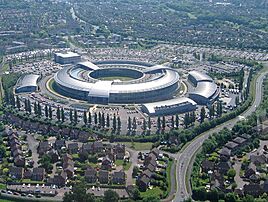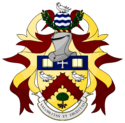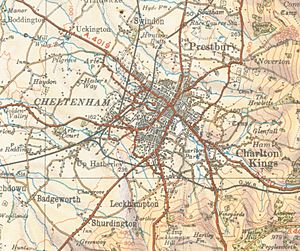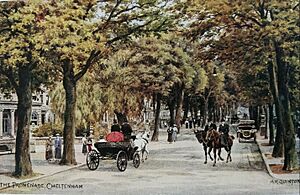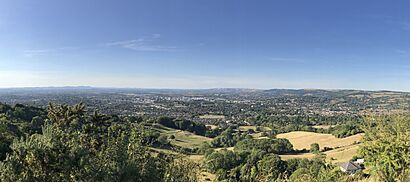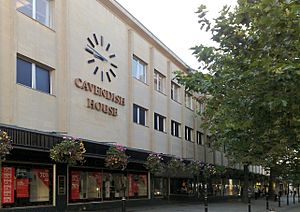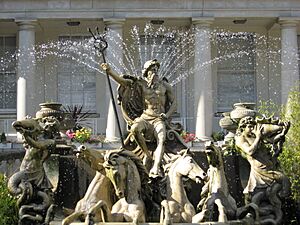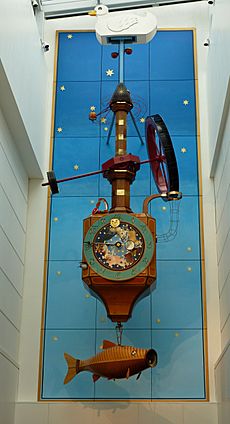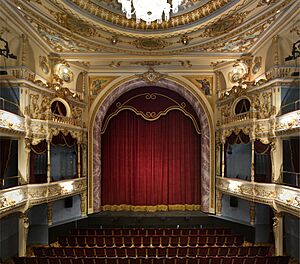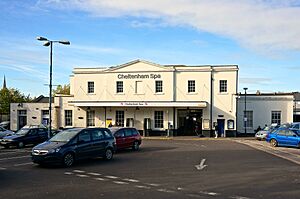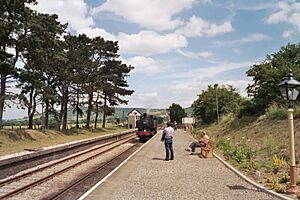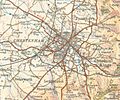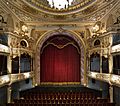Cheltenham facts for kids
Quick facts for kids
Cheltenham
Cheltenham
|
||
|---|---|---|
| Cheltenham Spa | ||
|
|
||
|
||
| Motto(s):
Salubritas et Eruditio ("Health and Education")
|
||
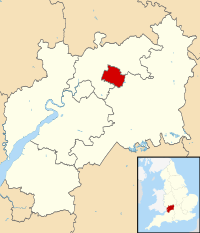
Cheltenham within Gloucestershire
|
||
| Country | United Kingdom | |
| Constituent country | England | |
| Region | South West England | |
| Ceremonial county | Gloucestershire | |
| Borough | Cheltenham | |
| Area | ||
| • Borough | 18.00 sq mi (46.61 km2) | |
| Area rank | Ranked 275th | |
| Population
(2021 census)
|
||
| • Borough | 118,836 | |
| • Rank | Ranked 203rd | |
| Ethnicity (2021) | ||
| • Ethnic groups |
List
|
|
| Religion (2021) | ||
| • Religion |
List
45.5% Christianity
44.4% no religion 8.6% other 1.5% Islam |
|
| Postcode |
GL50, GL51, GL52, GL53, GL54
|
|
| Area code(s) | 01242 | |
| OS grid reference | SO945225 | |
Cheltenham is a lively town in Gloucestershire, England. It sits right on the edge of the beautiful Cotswolds hills. People have known Cheltenham as a special health and holiday town since 1716. That's when they found natural mineral springs there! It's famous for its amazing Regency buildings, making it look like a town from a storybook. Cheltenham is just northeast of Gloucester.
This town is a hub for many exciting festivals. These include events for literature, jazz, science, and music. Famous people from all over the world come to these festivals. There's also the Cheltenham Cricket Festival and a food festival. If you love horse racing, the Cheltenham Gold Cup is a huge event. It happens every March as part of the Cheltenham Festival.
Contents
- Discovering Cheltenham's Past
- Exploring Cheltenham's Location
- What is Cheltenham's Weather Like?
- Cheltenham's Economy and Jobs
- Culture and Fun in Cheltenham
- Who Lives in Cheltenham?
- Learning in Cheltenham
- Local News and Radio
- Sports and Fun Activities
- Getting Around Cheltenham
- Churches in Cheltenham
- Cheltenham's Twin Towns
- Famous People from Cheltenham
- Images for kids
- See also
Discovering Cheltenham's Past
Cheltenham is named after the River Chelt. This river starts nearby and flows through the town. The town was first mentioned in records way back in 803. Its name likely means "settlement by a steep hill." It was an important royal area, even appearing in the old Domesday Book. In 1226, Cheltenham was given the right to hold a market.
Cheltenham became famous as a spa town after mineral springs were found in 1716. Captain Henry Skillicorne saw a great chance to use these springs. He married Elizabeth Mason in 1732, and her family owned the land with the first spring. Captain Skillicorne, who had traveled a lot, knew how to make the spa popular.
In 1738, he started making improvements. He built a pump for the water and a fancy building with a ballroom and billiard room for visitors. He also designed lovely tree-lined paths and gardens. These places had great views of the countryside. Soon, important people from all over came to enjoy the healing waters.

A big moment for Cheltenham was in 1788. King George III, his queen, and princesses visited the spa. This made Cheltenham a very fashionable place to go. You can still try the spa waters today at the Pittville Pump Room. This beautiful building was finished in 1830. It's a key part of Pittville, a planned expansion of Cheltenham to the north.
Cheltenham's success as a spa town is clear. Its railway station is still called Cheltenham Spa. Other towns even named their spa facilities after Cheltenham.
Did you know that Alice Liddell and Lewis Carroll often visited a house in Charlton Kings? This is a suburb of Cheltenham. Alice Liddell's grandparents owned the house. It's said that the mirror there inspired Lewis Carroll's book Through the Looking-Glass. This famous book came out in 1871.
Horse racing started in Cheltenham in 1815. It became a huge national event after the Festival began in 1902. Tens of thousands of people visit the racecourse each year for the festival. This brings a lot of excitement to the town.
During the Second World War, Cheltenham played an important role. The United States Army Services of Supply set up its main base here. The Cheltenham Racecourse became a giant storage area for trucks, jeeps, and tanks. Most of these were sent to Europe after the D-Day invasion.
The first British jet aircraft, the Gloster E.28/39, was partly built in Cheltenham. Manufacturing moved to Regent Motors on High Street. This was seen as a safer place from bombing during the war.
Exploring Cheltenham's Location
Cheltenham is located on the edge of the Cotswolds. This area is known for its amazing natural beauty. The small River Chelt flows through the town.
Cleeve Hill offers great views of Cheltenham. It is the highest point in Gloucestershire. It is also the highest point in the Cotswold Hills.
The town is about 88 miles (142 km) west-northwest of London. It's also 38 miles (61 km) northeast of Bristol. And it's 41 miles (66 km) south of Birmingham.
What are Cheltenham's Neighbourhoods?
Cheltenham has many different areas, or neighbourhoods. Some of these include Arle, Benhall, Charlton Kings, Fairview, and Montpellier. Other areas are Pittville, Prestbury, and Swindon Village.
Some parts of Cheltenham have special green spaces around them. This is called a green belt. It helps keep the town from growing too much. It also protects smaller villages nearby.
What is Cheltenham's Weather Like?
Cheltenham has a mild oceanic climate. This means it has warm summers and cool winters. The town once held the record for the highest temperature in Britain. It reached 37.1°C (98.8°F) in 1990. The coldest temperature ever recorded was -20.1°C (-4.2°F) in December 1981.
On average, it rains about 145 days a year. There are also about 42 nights with frost.
| Climate data for Cheltenham (1991–2020 normals, extremes 1889–2001) | |||||||||||||
|---|---|---|---|---|---|---|---|---|---|---|---|---|---|
| Month | Jan | Feb | Mar | Apr | May | Jun | Jul | Aug | Sep | Oct | Nov | Dec | Year |
| Record high °C (°F) | 15.0 (59.0) |
18.0 (64.4) |
22.2 (72.0) |
26.7 (80.1) |
29.4 (84.9) |
34.6 (94.3) |
35.9 (96.6) |
37.1 (98.8) |
32.6 (90.7) |
26.7 (80.1) |
17.5 (63.5) |
16.2 (61.2) |
37.1 (98.8) |
| Mean daily maximum °C (°F) | 8.0 (46.4) |
8.6 (47.5) |
11.3 (52.3) |
14.6 (58.3) |
18.1 (64.6) |
20.8 (69.4) |
23.2 (73.8) |
22.2 (72.0) |
19.5 (67.1) |
15.1 (59.2) |
11.0 (51.8) |
8.5 (47.3) |
15.1 (59.2) |
| Daily mean °C (°F) | 5.2 (41.4) |
5.5 (41.9) |
7.5 (45.5) |
9.9 (49.8) |
13.2 (55.8) |
15.9 (60.6) |
18.3 (64.9) |
17.7 (63.9) |
15.0 (59.0) |
11.5 (52.7) |
8.0 (46.4) |
5.5 (41.9) |
11.1 (52.0) |
| Mean daily minimum °C (°F) | 2.3 (36.1) |
2.3 (36.1) |
3.6 (38.5) |
5.1 (41.2) |
8.2 (46.8) |
11.0 (51.8) |
13.4 (56.1) |
13.2 (55.8) |
10.5 (50.9) |
7.9 (46.2) |
4.9 (40.8) |
2.4 (36.3) |
7.1 (44.8) |
| Record low °C (°F) | −20.1 (−4.2) |
−13.9 (7.0) |
−11.7 (10.9) |
−6.1 (21.0) |
−3.3 (26.1) |
−0.3 (31.5) |
2.8 (37.0) |
1.6 (34.9) |
−0.8 (30.6) |
−6.1 (21.0) |
−8.6 (16.5) |
−13.1 (8.4) |
−20.1 (−4.2) |
| Average precipitation mm (inches) | 78.0 (3.07) |
65.8 (2.59) |
51.3 (2.02) |
69.2 (2.72) |
65.5 (2.58) |
71.3 (2.81) |
70.4 (2.77) |
72.3 (2.85) |
69.2 (2.72) |
80.5 (3.17) |
88.8 (3.50) |
84.8 (3.34) |
867.2 (34.14) |
| Average precipitation days (≥ 1.0 mm) | 12.8 | 11.0 | 10.7 | 11.4 | 11.0 | 10.5 | 10.7 | 11.2 | 10.2 | 12.6 | 13.7 | 13.4 | 139.0 |
| Mean monthly sunshine hours | 56.9 | 80.0 | 116.1 | 158.6 | 195.0 | 189.4 | 200.6 | 181.2 | 141.4 | 106.5 | 64.3 | 52.8 | 1,542.8 |
| Source 1: Met Office | |||||||||||||
| Source 2: Starlings Roost Weather | |||||||||||||
Cheltenham's Economy and Jobs
Tourism is a big part of Cheltenham's economy. Many people visit the spa town. But it also has other businesses. These include food processing, aerospace, and electronics.
The government's electronic security agency, Government Communications Headquarters (GCHQ), is in Cheltenham. It's famous for its "doughnut-shaped" building. Other big companies like GE-Aviation and UCAS (Universities & Colleges Admissions Service) also have offices here.
Cheltenham is a great place for shopping. It has large department stores like Cavendish House, which opened in 1823. The Regent Arcade is another popular shopping spot.
In 2017, the Beechwood Shopping Centre was taken down. A new, large John Lewis store was built in its place.
Some restaurants in Cheltenham have even won special awards. Two of them have a Michelin one-star rating.
How is Employment in Cheltenham?
In 2010, the unemployment rate in Cheltenham was 2.7%. This was much lower than the UK national average of 7.9%.
More recently, in 2023, the employment rate for people aged 16–64 was 81.3%. This was higher than the average for the South West region. The number of people looking for work has gone up slightly.
Culture and Fun in Cheltenham
What is Cheltenham's Architecture Like?
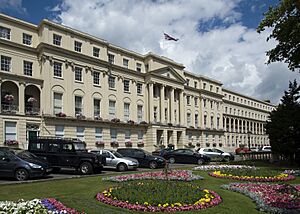
Cheltenham is famous for its beautiful Regency architecture. People say it's the "most complete Regency town in England." Many buildings are protected because of their history. The Cheltenham Synagogue is one example. It's known for its amazing design.

The Cheltenham Town Hall was built in 1902. It's a historic building that marks the coronation of King Edward VII and Queen Alexandra.
Where Can You Find Art in Cheltenham?
The Cheltenham Art Gallery & Museum, also called The Wilson, has many art shows. The Wilson is named after Edward Adrian Wilson, a polar explorer born in Cheltenham.
In 2014, a charity called The Cheltenham Trust took over many of the town's historic buildings. They now manage The Wilson, the Town Hall, and the Pittville Pump Room.
The Cheltenham Paint Festival brings together many mural artists. They come from all over the world to create amazing street art. In 2014, a famous street artist named Banksy created a piece of graffiti here. It showed three men listening in on a phone call.
Cheltenham also has some interesting sculptures:
- Neptune's Fountain in the Promenade, built in 1893.
- The Hare and the Minotaur, also in the Promenade, created in 1995.
- A life-size bronze Emperor Penguin at The Wilson museum.
- The Wishing Fish Clock in the Regent Shopping Arcade. This mechanical clock was designed by Kit Williams.
What About Music in Cheltenham?
Cheltenham hosts the yearly Cheltenham Music Festival and Cheltenham Jazz Festival. It also has the Ukulele Festival of Great Britain.
In 2010, Cheltenham was named the UK's fifth "most musical" city.
Many famous musicians were born in Cheltenham. These include Brian Jones from the Rolling Stones and Würzel from Motörhead. Gustav Holst, who wrote The Planets, was also born here. There's a museum and a monument for him in town. FKA Twigs is another well-known musician from Cheltenham.
What Museums and History Can You Explore?
The Cheltenham Art Gallery & Museum has a special collection of decorative arts. These are from the Arts and Crafts Movement era.
The Holst Birthplace Museum shows personal items of the composer. It also has a working Victorian kitchen and a Regency drawing room.
The Cheltenham Civic Society puts up special plaques around town. Blue plaques celebrate famous people. Green plaques mark important places and events.
What Festivals Does Cheltenham Host?
Cheltenham Festivals organizes several big festivals each year. These include music, jazz, literature, and science festivals. They bring in famous people from around the world. Events happen at places like the Cheltenham Town Hall and the Pittville Pump Room.
Other festivals include the Cheltenham International Film Festival and the Cheltenham Comedy Festival. The Cheltenham Festival of the Performing Arts is the oldest arts festival here. It started in 1926.
The Greenbelt (a Christian arts festival) and Wychwood Festival (a family-friendly music festival) used to be held at Cheltenham Racecourse.
Two big sporting events are also called the "Cheltenham Festival." These are the Cheltenham Cricket Festival and the National Hunt horse racing Cheltenham Festival.
Has Cheltenham Been in Films or TV?
Cheltenham has been a filming location for several movies and TV shows:
- Butterflies was mostly filmed here.
- If.... (1968) was filmed at Cheltenham College.
- The Whistle Blower, a spy thriller, used Cheltenham as a main location.
- The Full Monteverdi (2007) was partly filmed in Cheltenham.
- The House of Eliott (1991-1994) was partly filmed here.
- Vanity Fair (1998) was partly filmed in Cheltenham.
The Thistle Golden Valley Hotel was used for outdoor scenes in the soap opera Crossroads.
What Theatres are in Cheltenham?
Cheltenham has four theatres: the Everyman, the Playhouse, the Bacon, and the Parabola Arts Centre.
Who Lives in Cheltenham?
In 2021, the population of Cheltenham was about 118,866. This makes it the second largest town in Gloucestershire.
What are the Ethnicities and Religions?
According to the 2021 census:
- Most people (91.4%) are White.
- About 4.1% are Asian.
- About 2.5% are Mixed ethnicity.
- About 1.0% are Black.
- About 1.0% are other ethnic groups.
For religion:
- 45.5% are Christian.
- 44.4% have no religion.
- 1.5% are Muslim.
- 1.0% are Hindu.
- 0.5% are Buddhist.
- 0.2% are Jewish.
- 0.2% are Sikh.
- 8.6% follow other religions.
Cheltenham has many Christian churches. You can also find a Hindu Temple and a Mosque in the northern part of town.
Learning in Cheltenham
The oldest school in Cheltenham is Pate's Grammar School, founded in 1574. Cheltenham College (1841) was one of the first public schools of the Victorian period. This school was used for the film if.... in 1968. It also hosts the annual Cheltenham Cricket Festival, which started in 1872. This is the oldest cricket festival in the world.
Cheltenham Ladies' College (1853) is another very famous school in the town. Dean Close School was founded in 1886. The town also has several campuses of the University of Gloucestershire. There are other independent and state secondary schools too.
Local News and Radio
Local TV news for Cheltenham comes from BBC Midlands Today and BBC Points West. You can also watch ITV News Central and ITV News West Country.
For local radio, you can listen to BBC Radio Gloucestershire and Greatest Hits Radio South West. Heart West also broadcasts here. Cheltenham Radio is on air during the Cheltenham Festival.
The local newspaper is the Gloucestershire Echo.
Sports and Fun Activities

Cheltenham Racecourse is in the nearby village of Prestbury. It's the main place for National Hunt (jumps) horse racing in the UK. Races happen from October to April. The biggest event is the Cheltenham Gold Cup in March.
Cheltenham has football teams. Cheltenham Town F.C. is a professional team. There are also semi-professional teams like Bishops Cleeve F.C. and Cheltenham Saracens F.C..
Amateur rugby union clubs include Cheltenham R.F.C. and Old Patesians R.F.C..
The town has one golf course, Lilley Brook.
Cheltenham has one of the largest croquet clubs in the country. It's also home to the main office for the sport in the UK. The East Glos tennis, squash, and women's hockey club is also in town. It was founded in 1885.
Sandford Parks Lido is one of the biggest outdoor swimming pools in England. It has a 50-meter main pool, a children's pool, and a paddling pool. It's set in beautiful gardens. The Cheltenham Swimming and Water Polo Club is based here.
What is the Cheltenham Festival?
The Cheltenham Festival is a very important National Hunt racing event. It has the second-highest prize money after the Grand National. Many of the best British and Irish horses race here. This is quite rare during the rest of the racing season.
The festival happens every March at Cheltenham Racecourse. Many Irish visitors come to the event. This is because they love horse racing. Also, it often happens around St. Patrick's Day.
A lot of money is bet during the festival week. Hundreds of millions of pounds are gambled over four days. Cheltenham is famous for its exciting atmosphere. People often talk about the "Cheltenham roar." This is the huge noise the crowd makes when the first race starts.
Getting Around Cheltenham
Trains in Cheltenham
Cheltenham Spa railway station is a stop on the main train line between Bristol and Birmingham. It's often called Lansdown by locals.
Three train companies use this station:
- CrossCountry trains go to places like the South West, South Wales, the Midlands, and Scotland.
- Great Western Railway connects Cheltenham to Bristol Temple Meads, Worcester Foregate Street, Gloucester, and London Paddington.
- Transport for Wales runs services between Cheltenham Spa and South Wales.
The Cheltenham Spa Express is a special train connecting Cheltenham with London. It was once known as the Cheltenham Flyer. For a time, it was the fastest passenger train in the world!
Long ago, Cheltenham had eight railway stations. Now, only one main one remains.
The old Cheltenham Racecourse railway station has been restored. It's now the start of the heritage Gloucestershire Warwickshire Railway. This line was extended to Broadway in 2018.
Roads in Cheltenham
Cheltenham is close to the M5 motorway. This road connects Bristol and Birmingham. Junction 10 serves the north of town. Junction 11 connects to the south via the A40. The A40 continues towards Oxford and London.
Buses and Coaches in Cheltenham
Stagecoach West runs most of the bus services in Cheltenham. This includes routes to Gloucester and Tewkesbury.
National Express operates coach services from Cheltenham. You can take a coach to London and Heathrow Airport.
Churches in Cheltenham
The oldest church in Cheltenham is Cheltenham Minster, St Mary's. It's the only medieval building left in town. As the town grew, many other churches were built.
St Gregory's Roman Catholic church is a beautiful building. It was built between 1854 and 1857. The church has amazing stained glass windows.
Bell Ringing in Churches
Cheltenham has three churches where you can hear change ringing bells. One is at St Mark's Church. Another is at St. Christopher's (Warden Hill). This church has the lightest church bells in the world!
The third is at St. Mary's Church (the Minster). In 2017, new bells were put in here. The heaviest bell weighs over a ton.
Cheltenham's Twin Towns
Cheltenham is twinned with several towns around the world:
Twinning with Sochi, Russia, was paused due to recent events.
Famous People from Cheltenham
Many notable people have come from Cheltenham. These include musicians like Brian Jones and Gustav Holst. The explorer Edward Adrian Wilson was also born here.
Images for kids
-
Aerial of Cheltenham and the GCHQ
-
King George III in the 1780s
-
Cheltenham's Municipal Offices, an example of Regency architecture.
-
Cheltenham Town Hall erected in 1902 commemorate the coronation of King Edward VII and Queen Alexandra
-
The racecourse from Cleeve Hill
See also
 In Spanish: Cheltenham para niños
In Spanish: Cheltenham para niños






